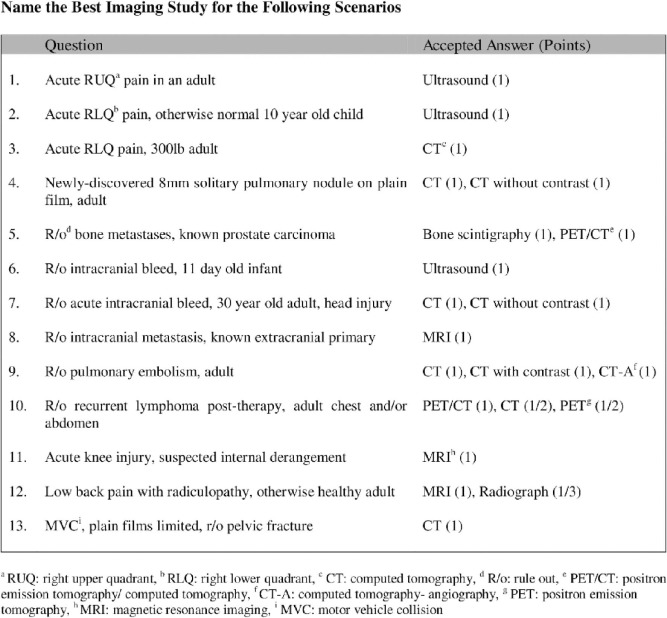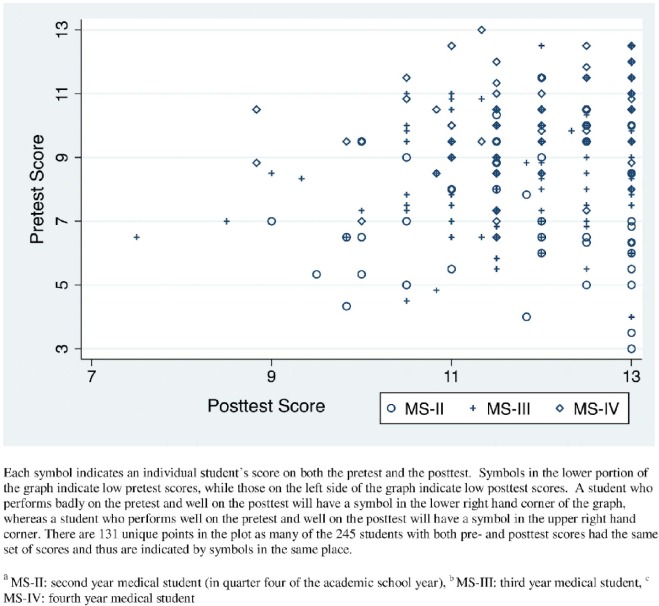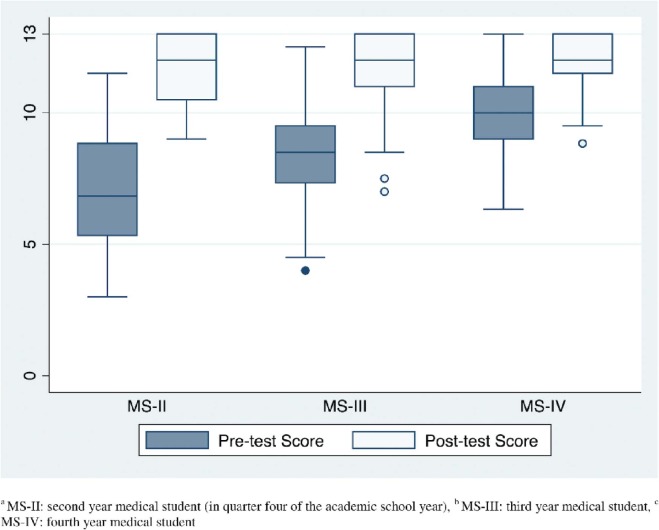Rationale and Objectives
Correct selection of imaging tests is essential for clinicians but until recently has been largely neglected in medical education. How and when students acquire such non-interpretive skills are unknown. This study will assess student knowledge of imaging test selection before and after a general radiology elective.
Materials and Methods
Between 2008 and 2015, an unannounced 13-item test was administered to second, third, and fourth-year students on the first and last days of the Johns Hopkins School of Medicine radiology elective. Scores (0–13) were based on the American College of Radiology Appropriateness Criteria. Pre- and posttest means were compared using paired samples t tests. Whether performance on the pretest and posttest differed by class year was assessed using analysis of variance and Kruskal-Wallis, respectively, and whether year was associated with posttest score after controlling for pretest score was assessed using analysis of covariance.
Results
Posttest means were significantly higher than pretest means for students in all years ( P values <.0001). Pretest scores differed by year (F (2, 360) = 66.85, P <.0001): fourth-year students scored highest (mean = 9.96 of 13) and second-year students scored lowest (mean = 7.01 of 13). Posttest scores did not differ (χ 2 (2, 270) = 0.348, P = .841). Year in school had no independent effect on posttest score (F (2, 239) = 0.45, P = .637).
Conclusion
Knowledge of modality selection increases with clinical training, but room for improvement remains. A general radiology elective increases this knowledge. Second-year students improve most, suggesting that taking radiology early is efficient, but further research to evaluate retention of this knowledge is needed. Medical student education in radiology must increasingly recognize and address non-interpretive skills and intelligent imaging utilization.
Introduction
Correctly choosing imaging tests is an essential skill for physicians in nearly all fields. As we enter the era of value-based health care, it will become even more important to obtain diagnostic imaging efficiently. However, this skill is woefully neglected in preclinical and clinical medical school training: at many institutions, only anatomy courses, if any, address radiology instruction in the preclinical years. Although our institution integrates imaging into all blocks of the preclinical and clinical curriculum, courses usually focus on identification of radiographic findings rather than choice of modalities for diagnosis. According to a 2014 survey by the American College of Radiology Task Force on Medical Student Education , fewer than 40% of schools have dedicated time for teaching imaging algorithms in the first 3 years of their medical school curricula.
Only a minority of schools—estimates from 2012 to 2014 range from 25% to 39% —have a mandatory dedicated radiology clerkship. Thus, the only exposure many students get to the field during their clinical years is through required medicine and surgery (or other) clerkships, in which interpreting computed tomography (CT) scans or chest radiographs is usually deemed more salient than knowing which studies to request. Although radiologists at our institution typically give one to two lectures to all rotating students per required clerkship, non-radiologists provide most of our clinical students’ radiology education.
Get Radiology Tree app to read full this article<
Get Radiology Tree app to read full this article<
Get Radiology Tree app to read full this article<
Materials and Methods
Get Radiology Tree app to read full this article<
Get Radiology Tree app to read full this article<
Get Radiology Tree app to read full this article<
Get Radiology Tree app to read full this article<
Get Radiology Tree app to read full this article<
Get Radiology Tree app to read full this article<
Get Radiology Tree app to read full this article<
Get Radiology Tree app to read full this article<
Results
Get Radiology Tree app to read full this article<
Get Radiology Tree app to read full this article<
Table 1
Summary of Pretest and Posttest Performance by Student Year a
Year Observations (N) Pretest Minimum Pretest Maximum Pretest Mean ± SD b ANOVA c Result Overall 363 3 13 9.01 ± 1.93 MS-II 42 3 11.5 7.01 ± 2.10 F (2, 363) = 66.85
P <.0001 MS-III 150 4 12.5 8.50 ± 1.74 MS-IV 170 6.33 13 9.96 ± 1.43
Posttest Minimum Posttest Maximum Posttest Mean ± SD Kruskal-Wallis d Result Overall 270 7 13 11.81 ± 1.16 MS-II 42 9 13 11.71 ± 1.19 χ 2 (2, 270) = 0.348
P = .841 MS-III 139 7 13 11.79 ± 1.23 MS-IV 98 8.83 13 11.87 ± 1.05
MS-IIs, MS-IIIs, and MS-IVs scored differently on the pretest ( P <.0001) but not on the posttest ( P = .841).
Get Radiology Tree app to read full this article<
Get Radiology Tree app to read full this article<
Get Radiology Tree app to read full this article<
Get Radiology Tree app to read full this article<
Get Radiology Tree app to read full this article<
Get Radiology Tree app to read full this article<
Get Radiology Tree app to read full this article<
Table 2
Paired t Tests: Difference Between Pretest and Posttest Means in MS-II a , MS-III b , and MS-IVs c
Year Observations (N) Pretest Mean ± SD d Posttest Mean ± SD Difference ± SD_t_ Test Result Overall 245 8.81 ± 1.99 11.90 ± 1.08 3.10 ± 2.08t = 23.35
P <.0001 MS-II 41 7.09 ± 2.08 11.70 ± 1.20 4.62 ± 2.33 t = 12.71
P <.0001 MS-III 116 8.51 ± 1.78 11.91 ± 1.11 3.40 ± 1.92t = 19.11
P <.0001 MS-IV 88 9.98 ± 1.42 11.98 ± 0.96 2.00 ± 1.53t = 12.25
P <.0001
Get Radiology Tree app to read full this article<
Get Radiology Tree app to read full this article<
Get Radiology Tree app to read full this article<
Get Radiology Tree app to read full this article<
Get Radiology Tree app to read full this article<
Get Radiology Tree app to read full this article<
Get Radiology Tree app to read full this article<
Get Radiology Tree app to read full this article<
Get Radiology Tree app to read full this article<
Discussion
Get Radiology Tree app to read full this article<
Get Radiology Tree app to read full this article<
Get Radiology Tree app to read full this article<
Get Radiology Tree app to read full this article<
Get Radiology Tree app to read full this article<
Get Radiology Tree app to read full this article<
Get Radiology Tree app to read full this article<
Get Radiology Tree app to read full this article<
Get Radiology Tree app to read full this article<
Get Radiology Tree app to read full this article<
Get Radiology Tree app to read full this article<
Get Radiology Tree app to read full this article<
Get Radiology Tree app to read full this article<
Get Radiology Tree app to read full this article<
Get Radiology Tree app to read full this article<
Appendix
Supplementary material
Get Radiology Tree app to read full this article<
Table S1
Get Radiology Tree app to read full this article<
Get Radiology Tree app to read full this article<
Get Radiology Tree app to read full this article<
Table S2
Get Radiology Tree app to read full this article<
Get Radiology Tree app to read full this article<
References
1. Straus C.M., Webb E.M., Kondo K.L., et. al.: Medical student radiology education: summary and recommendations from a national survey of medical school and radiology department leadership. J Am Coll Radiol 2014; 11: pp. 606-610.
2. Kondo K.L., Swerdlow M.: Medical student radiology curriculum: what skills do residency program directors believe are essential for medical students to attain?. Acad Radiol 2013; 20: pp. 263-271.
3. Kapoor N., Smith S.E.: Association between medical school radiology curricula and application rates to US radiology residency programs. J Am Coll Radiol 2014;
4. Poot J.D., Hartman M.S., Daffner R.H.: Understanding the US medical school requirements and medical students’ attitudes about radiology rotations. Acad Radiol 2012; 19: pp. 369-373.
5. Saha A., Roland R.A., Hartman M.S., et. al.: Radiology medical student education: an outcome-based survey of PGY-1 residents. Acad Radiol 2013; 20: pp. 284-289.
6. Nyhsen C.M., Lawson C., Higginson J.: Radiology teaching for junior doctors: their expectations, preferences and suggestions for improvement. Insights Imaging 2011; 2: pp. 261-266.
7. American College of Radiology. ACR Appropriateness Criteria® : Appropriateness criteria. Available at: https://acsearch.acr.org/list Accessed June 5, 2015
8. Leschied J.R., Knoepp U.S., Hoff C.N., et. al.: Emergency radiology elective improves second-year medical students’ perceived confidence and knowledge of appropriate imaging utilization. Acad Radiol 2013; 20: pp. 1168-1176.
9. Dillon J.E., Slanetz P.J.: Teaching evidence-based imaging in the radiology clerkship using the ACR appropriateness criteria. Acad Radiol 2010; 17: pp. 912-916.
10. Collins J., Riebe J.D., Albanese M.A., et. al.: Medical students and radiology residents: can they learn as effectively with the same educational materials?. Acad Radiol 1999; 6: pp. 691-695.
11. Feigin D.S., Smirniotopoulos J.G., Neher T.J.: Retention of radiographic anatomy of the chest by 4th-year medical students. Acad Radiol 2002; 9: pp. 82-88. Available at: http://doi.org/10.1016/S1076-6332(03)80299-4 Accessed April 29, 2015
12. Feigin D.S., Magid D., Smirniotopoulos J.G., et. al.: Learning and retaining normal radiographic chest anatomy: does preclinical exposure improve student performance?. Acad Radiol 2007; 14: pp. 1137-1142. Available at: http://doi.org/10.1016/j.acra.2007.06.023 Accessed April 29, 2015
13. Magid D., Hudson D.W., Feigin D.S.: Chest radiographic anatomy retention: the impact of preclinical groundwork on clinical recall in two schools. Acad Radiol 2009; 16: pp. 1443-1447. Available at: http://doi.org/10.1016/j.acra.2009.07.012 Accessed April 29, 2015
14. American College of Radiology and Radiological Society of North America : Image Wisely: initiative to help providers reduce radiation dose adults receive from medical imaging scans 29 Nov. Available at: http://www.imagewisely.org/media-room/press-releases/press-releases/image-wisely-press-release Accessed June 4, 2015
15. Alliance for Radiation Safety in Pediatric Imaging : Image gently: campaign overview. Available at: http://www.imagegently.org/About-Us/Campaign-Overview Accessed June 2, 2015
16. American College of Physicians : ACP: high value care. Available at: https://hvc.acponline.org/index.html Accessed May 1, 2015


